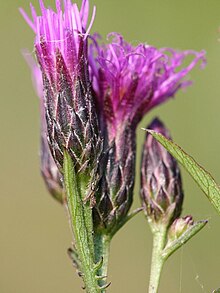Notches (genus)
| Nicks | ||||||||||||
|---|---|---|---|---|---|---|---|---|---|---|---|---|

Large-headed saw-wort ( Serratula tinctoria subsp. Monticola ) |
||||||||||||
| Systematics | ||||||||||||
|
||||||||||||
| Scientific name | ||||||||||||
| Serratula | ||||||||||||
| L. |
The nicks ( Serratula ) are a genus in the subfamily Carduoideae within the family of the daisy family (Asteraceae). There are only two species left in Eurasia . The dyer's notch ( Serratula tinctoria ) was and is used again as a dyer's plant.
description



Appearance and leaves
Serratula species grow as perennial herbaceous plants . The upright stems are mostly branched in the upper half.
The alternate leaves are pinnate, pinnate or rarely undivided. The leaf margin is serrated or serrated.
Inflorescences, flowers and fruits
In panicle or umbrella panicle total inflorescences some to many cup-shaped partial inflorescences stand together. The involucre is egg-shaped, hemispherical or bowl-shaped. The bracts cover each other like roof tiles, they usually get darker towards the top, the upper end is pointed and the inner ones are the longest. In the flower heads of the Carduoideae , in contrast to the other subfamilies, there are only tubular flowers . Either all of the tubular flowers are hermaphroditic or some of the flowers are female, in which case it is a question of gyno . At the edge of the flower head there are often female flowers that are hardly longer than the hermaphrodite; they contain staminodes . The flower crowns are purple to pink in color. The two branches of the style are thin.
The bald achenes have a rounded upper end. The pappus consists of several rows of the same finely sawn or rough pappus bristles.
Systematics
The genus Serratula was 1753 with the type species Serratula tinctoria L. by Linnaeus in Species Plantarum , 2, p 816 first published . A synonym for Serratula L. is Mastrucium Cass. The generic name Serratula is derived from the Latin word serratus for sawn and refers to the leaf edge.
The genus Serratula belongs to the subtribe Centaureinae of the tribe Cynareae in the subfamily Carduoideae within the family of the Asteraceae .
The scope of the genus Serratula has changed significantly in the last 200 years and many species have been placed in other genera. In 2005, Ludwig Martins & Frank H. Hellwig placed most of the Serratula species remaining in the genus Klasea Cass.
Only two species of the genus Serratula that are widespread in Eurasia remain :
- Crowned notch ( Serratula coronata L. , Serratula wolffii Andrae ): It is from Eastern Europe via Russia , Kazakhstan , Kyrgyzstan , Mongolia , Korea to Japan and in the Chinese provinces of Anhui , southeastern Gansu , Guizhou , Hebei , Heilongjiang , western Henan , northwestern Hubei , northwestern Jiangsu , Jiangxi , Jilin , Liaoning , Nei Mongol , southern Shaanxi , eastern Shandong , Shanxi and northern Xinjiang are widespread.
-
Färber's Scharte ( Serratula tinctoria L. ): It is widespread from Europe to Siberia . There are about three subspecies:
- Large-headed dyer's notch ( Serratula tinctoria subsp. Monticola (Boreau) Berher , Syn .: Serratula monticola Boreau , Serratula macrocephala Bertol. , Serratula vulpii Fisch.-Oost. , Serratula tinctoria subsp. Macrocephala (Bertol.) Wilczek & Schinz , Serratula tinctoria subsp. vulpii (Fisch.-Oost.) Kerguélen ): It occurs from Spain via France and Switzerland to Italy and Austria.
- Serratula tinctoria subsp. seoanei (Willk.) M.Laínz (Syn .: Serratula seoanei Willk. ): It occurs from the Iberian Peninsula to France.
- Serratula tinctoria L. subsp. tinctoria
use
From Serratula coronata and Serratula tinctoria young leaves are eaten cooked. A beautiful, durable dye is obtained from the sap of the dyer's sip ( Serratula tinctoria ). The medicinal effects of Serratula tinctoria have been studied.
swell
- Zhu Shi, Ludwig Martins: Serratula , p. 188 - online with the same text as the printed work , In: Zhu Shi, Eckhard von Raab-Straube, Werner Greuter, Ludwig Martins: Cardueae. In: Wu Zheng-yi, Peter H. Raven, Deyuan Hong (eds.): Flora of China , Volume 20-21: Asteraceae. , Science Press and Missouri Botanical Garden Press, Beijing and St. Louis, 2011, ISBN 978-1-935641-07-0 . (Sections Description and Systematics)
- Ludwig Martins, Frank H. Hellwig: Systematic position of the genera Serratula and Klasea within Centaureinae (Cardueae, Asteraceae) inferred from ETS and ITS sequence data and new combinations in Klasea. In: Taxon , Volume 54, 2005, pp. 632-638, ISSN 0040-0262 .
Individual evidence
- ↑ a b c d e f Zhu Shi, Ludwig Martins: Serratula , p. 188 - online with the same text as the printed work , In: Zhu Shi, Eckhard von Raab-Straube, Werner Greuter, Ludwig Martins: Cardueae. In: Wu Zheng-yi, Peter H. Raven, Deyuan Hong (eds.): Flora of China , Volume 20–21: Asteraceae , Science Press and Missouri Botanical Garden Press, Beijing and St. Louis, 2011, ISBN 978-1 -935641-07-0 .
- ↑ First publication scanned at biodiversitylibrary.org.
- ↑ a b c d e f Werner Greuter (2006+): Compositae (pro parte majore). In: Werner Greuter, E. von Raab-Straube (Ed.): Compositae. : Datasheet Serratula. In: Euro + Med Plantbase - the information resource for Euro-Mediterranean plant diversity. Berlin 2011.
- ^ Serratula in the Germplasm Resources Information Network (GRIN), USDA , ARS , National Genetic Resources Program. National Germplasm Resources Laboratory, Beltsville, Maryland. Retrieved January 4, 2014.
- ^ Serratula coronata in Plants For A Future
- ^ Serratula tinctoria at Plants For A Future
Web links
- The Serratula species occurring in Austria with links to profiles.
- Serratula tinctoria subsp. monticola (Boreau) Berher In: Info Flora , the national data and information center for Swiss flora . Retrieved April 1, 2018.

